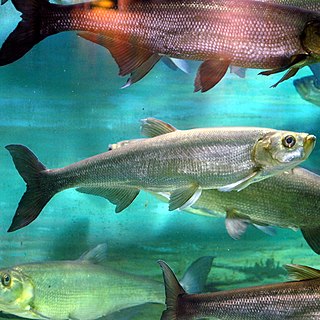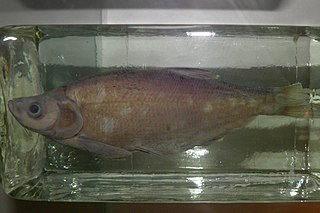
Misgurnus is a genus of true loaches found in Europe and Asia. The origin of the name Misgurnus comes from the Greek word miseo and the Turkish gür (loud), a name given to them due to their habit of becoming very active during barometric pressure changes that occur during thunderstorms. The common names, weather loach or weatherfish, also derive from this behavior. Some species of misgurnus are eaten, mostly in Asia, and are also sold as pets in the aquarium trade. Their average size can range from 6 to over 12 inches.

Chanodichthys is a genus of freshwater ray-finned fishes belonging to the family Xenocyprididae, the East Asian minnows or sharpbellies. The species in this genus are found in Eastern Asia. The name is derived from the Greek word chanos, meaning "abyss, mouth opened, inmensity", and the Greek word ichthys, meaning "fish". Chanodichthys is closely related to Culter and some species have been moved between these genera.

Culter is a genus of freshwater ray-finned fishes belonging to the family Xenocyprididae, the East Asian minnows or sharpbellies. The fishes in thsi genus are found in eastern Asia from Siberia to Viet Nam. The name is derived from the Latin word culter, meaning "knife". Culter is closely related to Chanodichthys and some species have been moved between these genera.

The sharpbelly or wild carp, sharpbelly, or common sawbelly, is a tropical freshwater and brackish water fish belonging to the family Xenocyprididae. It originates in large streams and reservoirs in China, Taiwan, Japan, Hong Kong, Korea, and the Amur River basin. It has become established as an exotic species in several other countries, including Iran, Afghanistan, and the former Soviet Union, where it has displaced local species. It was originally described as Culter leucisculus by S. Basilewsky in 1855, and has also been referred to as Chanodichthys leucisculus and Hemiculter leucisculus warpachowskii in scientific literature.

Hypophthalmichthys is a genus of large freshwater ray-finned fishes belonging to the family Xenocyprididae, the East Asian minnows or sharpbellies. This genus contains three species. The name comes from Greek ὑπό, ὀφθαλμός, and ἰχθῦς, thus 'fish with eyes below', referring to the fact that the fish has its eyes below the mouth line. Members of this genus are native to fresh water in East Asia, ranging from Siberia to Vietnam, but have been widely introduced outside their native range, where often considered invasive. Big head and silver carps have been reaching the Illinois River system outside of Lake Michigan but have grown concerns of them likely being established in the Great Lakes. The reason is that stakeholders, such as fisheries, recreationists, and the fishing industry can be impacted economically and potentially decrease biodiversity or even extinction of these or other species. Environmental DNA has been used to monitor these species and look for positive eDNA detections and the presence of live organisms. The genus is also known as Bighead carp, though that term is also used for individual species, particularly Hypophthalmichthys nobilis. The Russian language has a special word for the genus - tolstolób(ik).

The golden loaches (Sabanejewia) are a genus of ray-finned fish in the family Cobitidae.
Anabarilius duoyiheensis is a species of freshwater ray-finned fish belonging to the family Xenocyprididae, the East Asian minnows or sharpbellies. This species is known only from Luoping County in Yunnan Province.
Anabarilius paucirastellus s a species of freshwater ray-finned fish belonging to the family Xenocyprididae, the East Asian minnows or sharpbellies. This species is endemic to Yunnan, in the Red River basin.
Chanodichthys abramoides is a species of ray-finned fish belonging to the family Xenocyprididae, the East Asian minnows or sharpbellies. This fish is is endemic to the southern part of the lower Amur river system, including the Sungari and Ussuririvers and Lake Khanka, in Heilongjiang and Jilin provinces in China and in Amur. Primorsky Krai and Khabarovsk Krai districts in Russia.
Chanodichthys flavipinnis is a species of freshwater ray-finned fish belonging to the family Xenocyprididae, the East Asian minnows or sharpbellies. This species is endemic to Vietnam.
Hemiculter tchangi is a species of freshwater ray-finned fish belonging to the family Xenocyprididae, the East Asian minnows or sharpbellies. This species has only been recorded from the upper reaches of the Yangtze River in Sichuan.
Barbucca is a genus of loaches native to Southeast Asia. It is currently the only genus in its family.
Ancherythroculter is a genus of freshwater ray-finned fish belonging to the family Xenocyprididae, the East Asian minnows or sharpbellies.. The fishes in this genus occur in eastern Asia in China and Vietnam. There are currently five recognized species in this genus, though the validity of A. lini was under some doubt.
Araiocypris is a monospecific genus of freshwater ray-finned fish belonging to the family Xenocyprididae, the East Asian minnows or sharpbellies. The only species in the genus is Araiocypris batodes, a very small fish endemic to Vietnam.

Candidia is a genus of freshwater ray-finned fishes belonging to the family Xenocyprididae. This is a small genus with two valid species, all of which are endemic to Taiwan.
Elopichthys is a monospecific genus of freshwater ray-finned fish belonging to the family Xenocyprididae, the East Asian minnows or sharpbellies. The only species in the genus is Elopichthys bambusa, the yellowcheek or kanyu, a large fish that is found in freshwater habitats in eastern Asia. It ranges from the Amur River in Russia, through China to the Red and Lam Rivers in Vietnam. It prefers relatively warm waters, entirely avoiding colder highlands. It is considered an important food fish where it occurs, reaching up to 2 m in total length and 52.2 kg (115 lb) in weight.
Hainania serrata, also known as the Hainan minnow, is a species of freshwater ray-finned fish belonging to the family Xenocyprididae. the East Asian minnows or sharpbellies. This fish is found in fast flowing hill streams in southern China and Vietnam. It is the only member of the genus Hainania.
Hemiculterella is a genus of freshwater ray-finned fishes belonging to the family Xenocyprididae, the East Asian minnows or sharpbellies. The fishes in this genus occur in eastern Asia. There are currently three species in this genus.
Ancherythroculter wangi is a species of freshwater ray-finned fish belonging to the family Xenocyprididae, the East Asian minnows or sharpbellies. It lives in the upper Changjiang River in China.
Aphyocypris kikuchii is a species of freshwater ray-finned fish belonging to the family Xenocyprididae, the East Asian minnows or sharpbellies. It is endemic to Taiwan. It is a benthopelagic freshwater fish that grows to 8 cm (3.1 in) total length.







